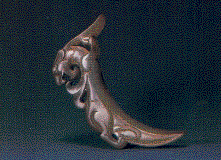


 |  | 
|

Introduction to Chinese Jade Of all materials in the world of Chinese antiquities, jade best exemplifies the essential aspects of Chinese culture and aesthetic appreciation. This beautiful stone is admired for its hardness, translucent colours and warm brilliance. From these natural properties the ancients found the embodiment of the cardinal virtues of a perfect gentleman. Ancient texts such as Li Ji (Book of Rites) expounded the importance of jade to a gentleman whose wearing of jade pendants achieved both moralizing and ornamental purposes. With time jade came to be identified as a symbol for everything that is good, pure, noble and sublime.
The art of jade-carving in China had its beginning early in the Neolithic perio d. The zoomorphic slit disk of the Hongshan culture, the axe-shaped tablets and flat sceptres of the Dawenkou and Longshan cultures, and the congs of the Liangz hu culture in the present exhibition demonstrate that jades had been widely used in all occasions as ritual objects, ornaments, tools and mortuary items. During the Bronze Age of the Xia, Shang and Zhou dynasties, ritual jades gave way to p endants sets and ornamental items, with shapes ranging from zoomorphic dragons, tigers, fish and birds, to sophisticated pendant sets comprising of disks, segments, tubes and plaques. The zoomorphic or geometric decorations were executed with well developed techniques of incised single lines, raised thread lines, relief carvings and openworks. The various zoomorphic pendants of the Shang dynasty, the human figure of the Western Zhou, and the openwork ornaments with interlocking dragons of the Eastern Zhou period are star pieces of this period. In Qin and Han dynasties, complex jade pendant sets were gradually dispensed with, and coincided with the popular belief in after-life, a great many mortuary jades were unearthed from burials of this period. New shapes appeared alongside delicate openwork carving. Typical pieces of this period in the exhibition include disks with openwork inner rings, sword fittings, cicadas, pigs and the unique winged cup. They represent the realistic and bold style of the Han dynasty.
About the Collection and Exhibition A total of 239 jades, all selected from Dr. Simon Kwan's (Guan Shanming) private collection were featured in the exhibition held in the Art Gallery, Institute of Chinese Studies, CUHK (16 July-9 Oct, 1994).
A catalogue of the exhibition Chinese Archaic Jades from the Kwan Collection can be ordered from the Institute. Fax: +852-2603 5366.
* Title image: #208 Claw-shaped openwork pendant, Western Han (206 B.C.-A.D. 8)


 The Research Institute for the Humanities, The Chinese University of Hong Kong.
The Research Institute for the Humanities, The Chinese University of Hong Kong.